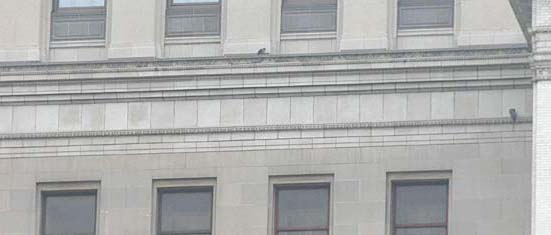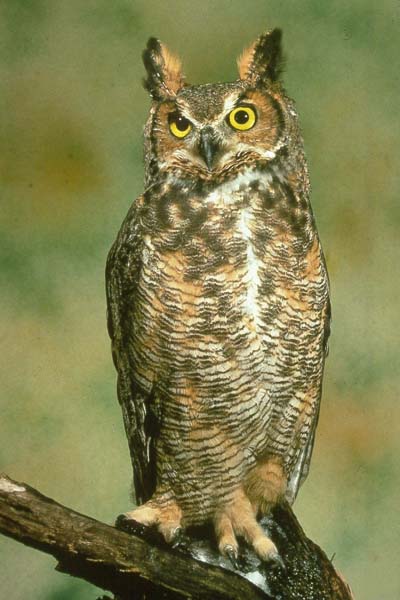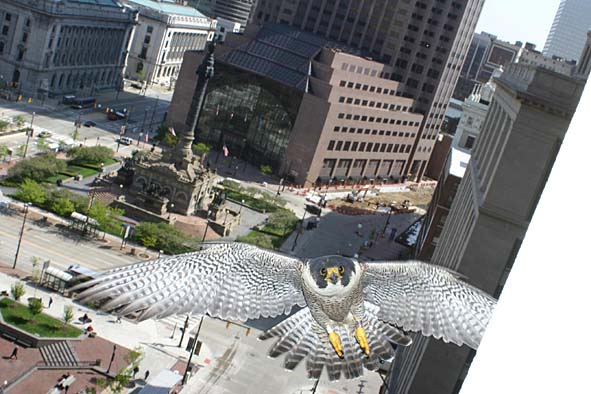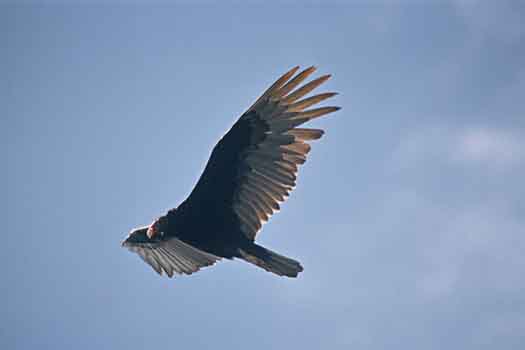FALCON FLASH
Dateline: Cleveland, Ohio
June 6, 2012
Click here to read what happened earlier
Uno’s parents continue to take care of her as much as possible, but they will soon teach her to be independent of them.
Watch the falcons live at: http://www.falconcam-cmnh.org/news.php
Our thanks to the Cleveland Museum of Natural History for sponsoring the FalconCams.
The picture of the owl comes from the National Park Service and the vulture from the U.S. Fish and Wildlife Service. The picture of the falcon chasing a redtail hawk is courtesy of volunteers Mr. and Mrs. Saladin. Other photos are courtesy of Mr. Scott Wright, volunteer peregrine nest monitor, and may be used in any non-commercial publication, electronic or print, but please give photo credit.
Uno is flying high and successfully, according to volunteer peregrine nest monitor, Mr. Scott Wright, who has visited the falcons’ skyscraper home and found her on the 36th floor.
Mr. Wright describes a successful flight, although she is still a beginner: “She made a short flight, as she made two 360's she was able to climb to the 41st floor! Keep in mind the wind was screaming way up there.
As she flew, she flapped as she went into the wind and soared as she flew with a tail wind. Silly Girl. You flap with a tail wind and soar to get lift into the wind. She will learn. Very good flight, very good I say”.
Here she is on the 41st floor, way up high.
Her parents continue to watch over her and feed her and soon they will begin to teach her to hunt on her own.
After the peregrine falcon becomes a mature adult, it is at the top of the food chain and does not fear other predators, but before the eyasses learn to fly, peregrine parents must watch over their young to protect them from predators - especially the great horned owl.
For city falcons, this is not much of a problem, since great horned owls are not common in cities. It is possible that many peregrine couples have decided to nest in cities across North America because there are few, if any, predators on skyscrapers. In fact, as humans were helping the species to recover from the brink of extinction, nestboxes were placed on skyscrapers and bridges with the hope of avoiding predation by the great horned owl. The great horned owl is a very large bird of prey (much larger than the crow-sized peregrines) with a wingspan of nearly 5 feet. An occasional owl does show up near the skyscraper, however. Scott Wright, volunteer nest monitor, was told by the Ohio Division of Wildlife one year that peregrines forced down a great horned owl who dared to fly near their nestsite. When the owl was found on a roof near the nest, it was missing an eye! For more information about the great horned owl visit:
In fact, peregrines don’t like anything near the nestsite. In this picture, SW flies at the window behind which volunteer nest monitor Mr. Wright was watching.
Quite a few watchers have spotted a falcon chase turkey vultures. A turkey vulture is a very large bird with a wingspan of up to 6 feet while a peregrine is about the size of a crow.
A falcon fan described a chase: “He (the falcon) actually landed momentarily on the vulture's back and I could see feathers falling to the ground. After the attack, the vulture flew faster than I have ever seen a vulture fly -- with the falcon right on his tail. It was quite an aerobatic show with both birds spinning and looping in the air”. For more information about turkey vultures go to:
Here is a picture of a male peregrine chasing a redtail hawk out of his territory.
Over the years Mr. Wright has reported that the male falcon (usually it's the male) has chased off interlopers much larger than himself who dare to cross the Falcon No-Fly Zone. Mr. Wright remembers, “The first male falcon at this nestsite, Szell, actually flew out and tried to attack a Goodyear blimp one year, flying out quite close and vocalizing the entire time until a representative of the Ohio Division of Wildlife called the Federal Aviation Authority - then the blimp never came close again!”
Peregrines are fiercely territorial and sometimes fight, if they must, to protect their nest. Twice at this nestsite, there have been fights between peregrines that resulted in the deaths of the losers. Many times, the falcons have dive-bombed humans who came too close, including this window washer.
Click here to read what happened next








